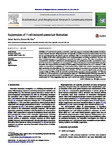Suppression of T cell-induced osteoclast formation
| dc.contributor.author | Karieb, S | |
| dc.contributor.author | Fox, SW | |
| dc.date.accessioned | 2023-02-15T15:20:51Z | |
| dc.date.available | 2023-02-15T15:20:51Z | |
| dc.date.issued | 2013-07 | |
| dc.identifier.issn | 0006-291X | |
| dc.identifier.issn | 1090-2104 | |
| dc.identifier.uri | http://hdl.handle.net/10026.1/20385 | |
| dc.description.abstract |
Inhibition of T cell derived cytokine production could help suppress osteoclast differentiation in inflammatory skeletal disorders. Bisphosphonates are typically prescribed to prevent inflammatory bone loss but are not tolerated by all patients and are associated with an increased risk of osteonecrosis of the jaw. In light of this other anti-resorptives such as phytoestrogens are being considered. However the effect of phytoestrogens on T cell-induced osteoclast formation is unclear. The effect of genistein and coumestrol on activated T cell-induced osteoclastogenesis and cytokine production was therefore examined. Concentrations of genistein and coumestrol (10(-7)M) previously shown to directly inhibit osteoclast formation also suppressed the formation of TRAP positive osteoclast induced by con A activated T cells, which was dependent on inhibition of T cell derived TNF-α. While both reduced osteoclast formation their mechanism of action differed. The anti-osteoclastic effect of coumestrol was associated with a dual effect on con A induced T cell proliferation and activation; 10(-7)M coumestrol significantly reducing T cell number (0.36) and TNF-α (0.47), IL-1β (0.23) and IL-6 (0.35) expression, whereas genistein (10(-7)M) had no effect on T cell number but a more pronounced effect on T cell differentiation reducing expression of TNF-α (0.49), IL-1β (0.52), IL-6 (0.71) and RANKL (0.71). Phytoestrogens therefore prevent the pro-osteoclastic action of T cells suggesting they may have a role in the control of inflammatory bone loss. | |
| dc.format.extent | 619-624 | |
| dc.format.medium | Print-Electronic | |
| dc.language | en | |
| dc.language.iso | eng | |
| dc.publisher | Elsevier BV | |
| dc.subject | Bone resorption | |
| dc.subject | T cell | |
| dc.subject | TNF-alpha | |
| dc.subject | Phytoestrogens | |
| dc.title | Suppression of T cell-induced osteoclast formation | |
| dc.type | journal-article | |
| dc.type | Article | |
| plymouth.author-url | https://www.ncbi.nlm.nih.gov/pubmed/23764400 | |
| plymouth.issue | 4 | |
| plymouth.volume | 436 | |
| plymouth.publisher-url | http://dx.doi.org/10.1016/j.bbrc.2013.05.140 | |
| plymouth.publication-status | Published | |
| plymouth.journal | Biochemical and Biophysical Research Communications | |
| dc.identifier.doi | 10.1016/j.bbrc.2013.05.140 | |
| plymouth.organisational-group | /Plymouth | |
| plymouth.organisational-group | /Plymouth/Faculty of Health | |
| plymouth.organisational-group | /Plymouth/Faculty of Health/School of Biomedical Sciences | |
| plymouth.organisational-group | /Plymouth/Research Groups | |
| plymouth.organisational-group | /Plymouth/Research Groups/Institute of Translational and Stratified Medicine (ITSMED) | |
| plymouth.organisational-group | /Plymouth/Research Groups/Institute of Translational and Stratified Medicine (ITSMED)/CBR | |
| plymouth.organisational-group | /Plymouth/Research Groups/Plymouth Institute of Health and Care Research (PIHR) | |
| plymouth.organisational-group | /Plymouth/Users by role | |
| plymouth.organisational-group | /Plymouth/Users by role/Academics | |
| dc.publisher.place | United States | |
| dcterms.dateAccepted | 2013-05-31 | |
| dc.identifier.eissn | 1090-2104 | |
| dc.rights.embargoperiod | Not known | |
| rioxxterms.versionofrecord | 10.1016/j.bbrc.2013.05.140 | |
| rioxxterms.licenseref.uri | http://www.rioxx.net/licenses/all-rights-reserved | |
| rioxxterms.licenseref.startdate | 2013-07-12 | |
| rioxxterms.type | Journal Article/Review |


